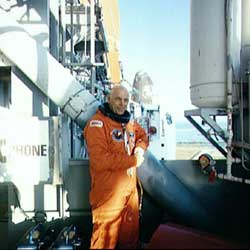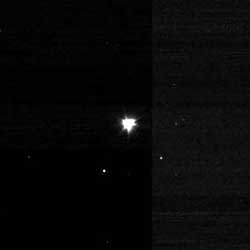
Story Musgrave on the launch pad for the space shuttle Discovery on mission STS-33. Image credit: NASA. Click to enlarge.
Listen to the interview: Interview with Story Musgrave (10 MB)
Or subscribe to the Podcast: universetoday.com/audio.xml
Fraser Cain: We’re just about two weeks away from the next space shuttle going up to return to flight after the Columbia tragedy. How would you feel if you were in the space shuttle?
Story Musgrave: I was never comfortable with the shuttle, of course. The risk is a lot higher than I ever wished to tolerate. I’m not a risk taker. I’ve survived in the aerospace world for 53 years, and I’m a professional who wants to come back and do it again next year. I’ve never been happy with the amount of risk that the shuttle is. But, I think the current mission will probably be one of the safest ever. I think they will have done as much as they can, and they will have looked after the details, so I think this current launch will be as safe as any they’ve ever done.
Fraser: What’s the experience like of launching on board the shuttle? Pretty violent, I guess.
Musgrave: Uh yeah, I’d call it violent. It’s a lot of vibration, a lot of noise, and you’re just hoping that butterfly will just stick to that bullet.
Fraser: There’s been a lot of controversy about the Hubble Space Telescope, about whether to continue the repairs or not. You led the team for the first repair mission. How do you feel about bringing Hubble back to service?
Musgrave: I think we’ll give it one more shot. I think we will go and service it one more time. That’s not over, that game is not over yet, and I expect we’ll service it one more time. It may not be on the books now; what is on the books is don’t preclude it, not to preclude that possibility. I think once we get the shuttle flying again, and certainly the public wants that done. There’s nothing much more important to the public. The public doesn’t understand the space station, they don’t know what’s there, they don’t know what we’re doing, they don’t see anything from it. Once we get the shuttle flying again, and we’ve got an idea about the difficulties there with ice or foam and the thermal protection system, then we’ll get that confidence back. I think we’ll get the confidence to take the shuttle to somewhere other than space station. As you probably know, the only issue is – it’s not a matter of money or anything – the issue is that every time you fly the shuttle until it’s flown out its lifetime, which people are talking 2010; should you take it to the space station every time? You do have a lifeboat, you do have a means of inspection, possibly of repair, and a place for the crew to hang out until rescue if there is a problem. It gets down to the basic question: are you willing to take the risk to fly the shuttle anywhere other than the space station, such as Hubble? You can not make it to Hubble, and then make it to space station. They’re in different planes, and it takes to much fuel to change planes. So you can’t do both. If you go to Hubble, you can’t make it to station.
Fraser: How do you feel about the new Vision for Space Exploration?
Musgrave: A vision of “out there”, I am very happy with, to go beyond Earth orbit. Space station was a terrible strategic error. We’ve not had a solid vision, of course, since the Moon and Skylab. For Skylab, our first space station, I was involved in developing, and as a backup crew member on the first one in 1973. Now the Apollo and the Skylab programs had a vision. We knew where we were going and what we wanted to do, and it was exploration and discovery. It kind of lost the way from that point on, in terms of staying in touch with the public, who wants exploration and discovery, wants a little further out there. The Voyagers, of course, were fantastic successes and this year they’re planning to pull the plug on them just for money purposes when, in fact, the Voyagers are defining the edge of the Solar System. A new vision at least has words “back to the Moon and to Mars”, so it’s a little further out. How that unfolds, of course, no one knows. Where the resources will come from when we transition from the current efforts we’re doing. Until we get out of the current efforts, there’ll be no money for the further out explorations. But they also have to be done right; we can’t leap off and go. We have to lead with the robots. They have to go first to establish habitats and science centres. They need to go first. So then you can do space optimally, low cost option for space. Lead with the robots. We have to do that this time.
Fraser: And do you feel that the US, and maybe the world in general are more interested in space and space exploration then maybe the governments give them credit?
Musgrave: Oh yeah, the people are. The people are usually interested in exploration and discovery; they’re very interested in what kind of Universe they’ve got; what’s their place in it. They’re interested in the big questions. So, that’s what they’re after. That’s what’s exciting about space. Not the spinoffs, not the technical spinoffs, not just the technology. They’re interested in discovering their Universe. They want some answers to their existential questions. What’s life mean here? What’s the meaning of hope? What am I doing here? So things like Hubble tend to bridge those gaps between cosmology and theology, philosophy and astronomy. And that’s why Hubble has always meant so much to people. That’s why for that kind of exploration and discovery, you can do it in a microscope as well. You could do it with really cutting edge science, all those things are exciting to people. But space, going out to beyond Earth, whether you do it with telescopes or other robots or eventually humans, that’s why people are excited about space.
Fraser: Astronomy and the search for life on Mars and so on has a chance to really put things in perspective here in the Universe.
Musgrave: You’ll never know. You can’t know what happened here until you find one other. Of course, contact, you know with linear time and linear distances is going to be very difficult, but no way will we understand how creation, evolution and intelligent beings and the information age all came to pass on this planet. We’ll never understand that until we see how that happened on some other body. And so that is critical, very critical. We’re dealing, as scientists, we’re dealing with a sample of one; how it happened and why it happened. With a sample of one, usually you can’t make conclusions from one. So all those things are highly important. But we can take small steps before we make contact. You can make steps in that the human species accepts the other long before you get the proof of contact. That’s part of our growth, part of our Copernican growth; do we accept other living creatures, and accept other intelligent creatures. It’s all part of the Copernican thing – the Universe does not go around the Earth. It’s part of the Darwinian thing about evolution, it’s part of Freud, of the subconscious, which is very important to human behaviour even though you can’t get at it. It’s Einstein’s Relativity, the Heisenberg uncertainty. Those kinds of things, they are part of our species’ growth. And so I think that long before we get to physical proof of it, that part of our growth will be universal among the species acceptance of the other.
Fraser: Do you think that humans are emotionally ready to make contact with other alien species?
Musgrave: No, they’re not. They’re not, and it won’t happen. Anything that is so advanced as to be doing interstellar travel, and you know with the trillions of planets out there that could support life, there is interstellar travel going on. They wouldn’t come here, we’re not ready. We’re not ready because we are not ready to meet members of our own species. I mean, there are 60 wars this week on planet Earth. So, if we’re not ready to meet – to embrace – members of our own species, let alone other creatures or a sustainable behaviour with Earth, we are not advanced enough in our globalization and in our moving further out until we think of ourselves as galactic creatures on the journey together. No, we’re not ready to meet them, and we would not welcome them – we’d send the guns first. It would be a national defense. It would be a national security issue, as opposed to a communications issue. I’m not a cynic, and I’m not being skeptical, I’m pointing at the facts… the pure facts. But it also points out that humans have got to get it together. They’ve simply got to get the will, the desire, to get it together. And that has not become more important than protecting the tribalism and protecting our provincial interests. You know, globalization of the species, where we become global creatures, and then solar system, and then galactic kinds of creatures which would live at a different transcendent level. That’s obtainable to us today if we only have the desire.
Fraser: Do you think that the universities and the schools and even the popular culture are doing a good job of popularizing space and astronomy and science right now?
Musgrave: Yes, I think they do a good job. That’s not the problem: what do we give them? What are we handing them? For example, let me come back to you and ask you a question, what are we giving them today?
Fraser: On the news, people are interested in Michael Jackson’s trial more than the things being discovered in space.
Musgrave: I absolutely agree that the Michael Jacksons to Britney Spears and the Donald Trumps are running the world. There’s no question about that, and I’m serious, they really are. If you look at the internet, if you look at the explosion of information with 100 television channels, and the massive number of books, magazines, print and the satellite communications, the internet, all the rest of that; if you look upon that as we’re almost forming a global brain here, or we have already – it may even be conscious. That’s a stretch, but how are we to know? You know, a single brain cell doesn’t know it’s part of a brain; it can’t see that great big picture. But the gate guarders, the people who run the media and the like. There are people who, when they sneeze, the entire system reverberates; they kick off huge waves that go through this massive global brain that we have. And it’s not the scientists, and it’s not the scientific information. That’s not necessarily just a problem with the space program, that’s a cultural problem. You want to build the people; you want to make the people so that when they sneeze, the whole brain shivers. You make them, and then you mine money from them. But that’s a process where we really do need to get our priorities and get beyond that.
Fraser: I see a few glimmers of hope, with shows like CSI where the scientists and geeks are the heroes. Back in the 60s and 70s, the astronauts were seen as heroes and as rock stars in that world, so it’s definitely possible. It’s almost as if, this is what’s currently in focus, so that’s all people care about.
Musgrave: I guess it boils down to a sense of values. What are our values? What are our species, what are our cultural, what are our national, what are our values in terms of what do we value?
Fraser: I wanted to go a bit into the recent CD that we reviewed here on Universe Today a little way back. Can you give me some background on what went into doing this CD, and the people that you worked with?
Musgrave: Well, it was mostly my son who was instrumental in that. And we have some other musicians which I adore: Jonn Serrie writes a lot about space music. Harry Roberts, we discovered him. He was just living across the street from Todd in Austin. Brian Eno, I’ve always adored his stuff, the Apollo track, and that. It’s basically a montage of things we recorded some of my poems in the studio, and then Harry added some music to them. It kind of evolved in that way to be a space themed audio.
Fraser: And having finished Cosmic Fireflies, do you think you’ll do another CD?
Musgrave: Yes, I think we will. I think it may focus a little more heavily. The poetry I wrote were mostly class assignments. One poem, the longer poem about orbit about the Earth I wrote for National Geographic magazine. But if I’d had it in mind ahead of time, that we’d put the poems to music, then I would maybe do some different things. But I didn’t know that’s where those things would end up, when I wrote them, or when I recorded them. So it’s possible that with the specificity in mind, it’s possible that I could do a better job although, there’s nothing much like spontaneity. I think a live audience is very nice too, so you might do a live poetry reading. And I do live programs to record on DVDs. I’m just wrapping up one now on Australia from space. I’m going down to Sydney in two weeks and probably put the wraps on that. We’ve been in post production here for a year.
Fraser: One question I get a lot from readers, is how do they become astronauts. One suggestion I’ve heard is to save up $20 million and pay for a trip to space. Do you have any advice for the next generation of astronauts out there?
Musgrave: I disagree with money, I disagree, I think that’s the wrong thing to do. Money, just like we were talking about earlier, who runs the world, with celebrity running the world with celebrity money and power, they all go together of course. I disagree with the idea that money should go into space. The artists, the poets and scientists and other teachers and stuff, they don’t get to go because they don’t have money. So I disagree with that grab for resources. We had a wonderful communicator in space program, teacher in space program, but of course, Christa McAuliffe died on Challenger and we haven’t had the courage to reinstitute that program. We took her backup, Barbara Morgan, we took her on as a regular astronaut so that we would eventually get a teacher into space. The wider range of people you put in space, the more richly you’re going to communicate what space is about. I’ve always been highly in favour of flying a diversity of people in space. Money should not be the deciding factor. Your ability to have the experience and bring it home for others should be the deciding factor. Now, new things are happening; there’s SpaceShipOne, and the Ansari X-Prize. So new things are happening, but it’s not going to open a huge door right away. Space is so critical, you have to do it right. You can’t just do it, you know. You can’t just do it to pull it off. So you have to do more deeper engineering, and backup systems, and safety systems, and escape systems, and you have to get more into those kinds of things. Tourism in space by private enterprise will be a little slower to happen than maybe we perceive now, as we see private ventures getting into it. It’s very important to have those innovative kinds of things happening. It’s exceedingly important because NASA’s not doing it.






